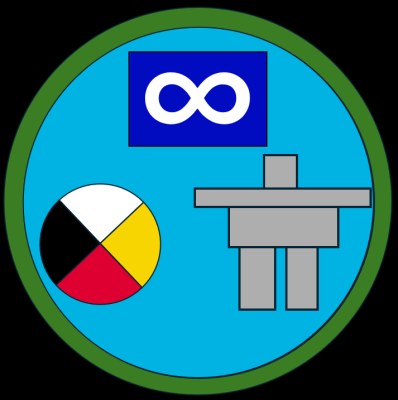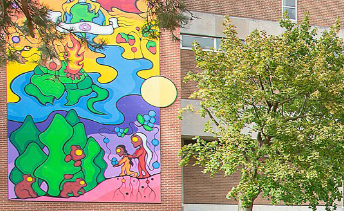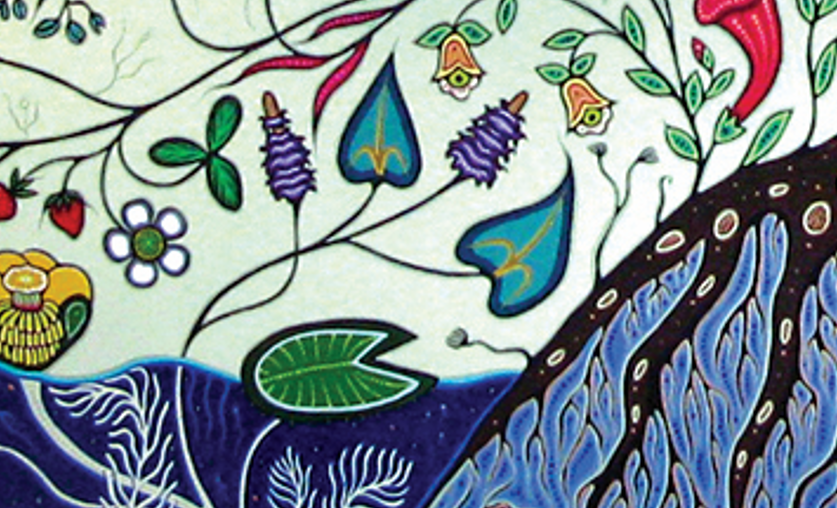National Indigenous History Month

National Indigenous History Month is a chance to reflect and learn about the history and the strengths of First Nations, Inuit, and Metis peoples in Canada. The resources below are a selection of events, art, and learning material to explore.
Where possible, immediate access to alternate formats for users with disabilities are provided, otherwise alternate format request options are provided.
Community members can learn how to access Laurier Library resources.
Mike Cywink's One Heart, One Mind, One Vision

Mike Cywink's One Heart, One, Mind, One Vision mural depicts multiple Indigenous teachings. It is located on the exterior of the southerly wall of the Waterloo campus library facing the Heritage Walk grove of trees (maples, flowering crab) and the Nadjiwan Kaandossiwin Gamik (Indigenous Student Centre).
As indicated in this YouTube video (closed captions), through the mural "Together, we wanted to celebrate and amplify indigenous culture, art, and history on campus and in our region."
Books and periodicals
Good, M. (2024). Truth telling : seven conversations about Indigenous life in Canada. Harper Perennial.
"From racism, broken treaties and cultural pillaging to the value of Indigenous lives and the importance of Indigenous literature, this collection reveals facts about Indigenous life in Canada that are both devastating and enlightening. Truth Telling also exposes the myths underlying Canadian history and the human cost of colonialism, showing how it continues to underpin modern social institutions in Canada.
Sterritt, A. (2023). Unbroken: My fight for survival, hope, and justice for Indigenous women and girls (1st ed.). Greystone Books Ltd.
As a Gitxsan teenager navigating life on the streets, Angela Sterritt wrote in her journal to help her survive and find her place in the world. Now an acclaimed journalist, she writes for major news outlets to push for justice and to light a path for Indigenous women, girls, and survivors. In her brilliant debut, Sterritt shares her memoir alongside investigative reporting into cases of missing and murdered Indigenous women in Canada, showing how colonialism and racism led to a society where Sterritt struggled to survive as a young person, and where the lives of Indigenous women and girls are ignored and devalued.
Talaga, T. (2024). The knowing (1st ed.). HarperCollins Publishers Ltd.
From Tanya Talaga, the critically acclaimed and award-winning author of Seven Fallen Feathers, comes a riveting exploration of her family's story and a retelling of the history of the country we now call Canada For generations, Indigenous People have known that their family members disappeared, many of them after being sent to residential schools, "Indian hospitals" and asylums through a coordinated system designed to destroy who the First Nations, Métis and Inuit people are. This is one of Canada's greatest open secrets, an unhealed wound that until recently lay hidden by shame and abandonment. The Knowing is the unfolding of Canadian history unlike anything we have ever read before.
Turtle Island news = Okarahsonha kenh Onkwehonwene. (1994 - present). Turtle Island News Publications.
Canada's only national Indigenous weekly newspaper, published every week at the Grand River Territory of the Six Nations in southern Ontario.
Audio & Video
Voices From here. (2020). Historica Canada.
The Voices from here video series features stories of First Nations, Inuit & Métis participants. Their stories shed light on histories of resilience and resurgence.
Bruce, C., Warrick, G. A., Six Nations Women Singers, & Silvercord Productions. (2007). Written in the earth [the story of Davisville] [Video recording]. Silvercord Productions.
The Six Nations Women Singers is one of the most influential female Native American singing groups.
Heartbeat : voices of First Nations women. (1995). [Broadcast]. Smithsonian/Folkways.
Powerful living music from Native women in the United States and Canada includes performances rarely heard beyond these artists’ communities. Ceremonial and social songs traditionally sung by women, other music now performed by women, and material that combines traditional and contemporary themes and musical forms. Thirty-four selections present a seamless range of solo, choral, and instrumental pieces, forming pulsating and driving music.
Obomsawin, A., Clarke, A., & National Film Board of Canada, film producer. (2022). Honour to Senator Murray Sinclair [Video recording]. National Film Board of Canada.
As the Chair of the Truth and Reconciliation Commission, Senator Murray Sinclair was a key figure in raising global awareness of the atrocities of Canada’s residential school system. With determination, wisdom and kindness, Senator Sinclair remains steadfast in his belief that the path to actual reconciliation between Indigenous and non-Indigenous people requires understanding and accepting often difficult truths about Canada’s past and present. Alanis Obomsawin shares the powerful speech the Senator gave when he accepted the WFM-Canada World Peace Award
Bettens, C. (Host). (2017-present). APTN News InFocus [Audio Podcast]. APTN News.
Weekly news stories about issues affecting Indigenous peoples - hosted by Red River Metis reporter Cierra Bettens
Deerchild, R. (Host). (2015-present). Unreserved [Audio Podcast]. CBC News.
Weekly CBC radio newscast featuring Indigenous voices and host Rosanna Deerchild.
Dorion, L. (Host). (2021). Paykiiwikay Metis Culture Podcast [Audio Podcast]. Metis Gathering.
A tour through the rich history of the Métis people of Saskatchewan, including their Michif language, and many cultural traditions based on their centuries of life in Canada's west and north. Hosted by Metis artist Leah Dorion.
LeMay, M. (Host). (2024). One Nation, Many Stories - A Métis National Council Podcast. [Audio Podcast]. Metis Nation.
This podcast will work to highlight the beautiful stories from across the Métis Homeland. Hosted by Matt LeMay.
Land Experiences
Grand River Conservation Authority, issuing body. (2024). Grand River Conservation Areas membership. Grand River Conservation Authority.
This pass, available through Laurier Library, allows entry to 10 Grand River Conservation Areas and the Luther Marsh Wildlife Management Area, during their operation seasons.
Kayanase Greenhouse, Six Nations
Kayanase is an ecological restoration and native plant and seed business. Their mission is to restore the health and beauty of Mother Earth, using science-based approaches and Traditional Ecological Knowledge (TEK).
Location: 993 Hwy #54 Brant County, Brantford, ON
Hours: Monday - Friday 8:30am - 4:00pm
Events
Indigenous Cultures within the Grand River at McDougall Cottage
In conjunction with the exhibit Currents of Change: Inspiring Action Along the Grand River, this event invites you to explore the enduring relationship between Indigenous peoples and the Grand River through storytelling, song, teachings, and hands-on creativity.
Date: Wednesday, June 18, 2025 6:00 pm - 8:00 pm
Location: 89 Grand Ave. S., Cambridge, ON - Waterloo Region Museum
Cost: Free
imagineNATIVE Film + Media Arts Festival
Explore provocative, inspiring, innovative and original cinema during imagineNATIVE, the world’s largest Indigenous film and media arts festival held annually in Toronto.
Closed captioning available for online viewing, ALS at in-person events, all venues are wheelchair accessible
Date: June 3-8, 2025 (Toronto) and June 9-15, 2025 (online)
Location: Different venues in Toronto
Previous Years Resources
2024
Christi Belcourt's Take Only What You Need Exhibition

In the Take Only What You Need exhibition, Christi Belcourt calls for self-reflection on nature’s symbolic properties and the earthly connections that intertwines human existence with the natural world. Image description provided for the blind and visually impaired.
Free Prior and Informed Consent (FPIC) resources
Free Prior and Informed Consent (FPIC) is an index and full text database that provides information and resources on self-determination to assist Indigenous communities in decision making. It includes selected articles, tool kits, videos, voice messages, and community stories about FPIC and Consultation. The website is hosted by Deyohahá:ge, the Indigenous Knowledge Centre, at Six Nations Polytechnic in the territory of Six Nations of the Grand, Oshweken, Ontario, Canada. Deyohahá:ge (Two Roads): “is dedicated to bringing together two streams of consciousness – the ancestral Indigenous knowledge with the best of modern academic knowledge – in order to advance the overall well-being of all peoples.”
Johnson (Tekahionwake), E. P., Capilano (Sahp-luk), J., Capilano (Lixwelut), M. A., & Shield, A. (2023). Legends of the Capilano. (1st ed.). University of Manitoba Press. https://doi.org/10.1515/9781772840193
Bringing the Legends home Legends of the Capilano updates E. Pauline Johnson’s 1911 classic Legends of Vancouver, restoring Johnson’s intended title for the first time. This new edition celebrates the storytelling abilities of Johnson’s Skwxwú7mesh (Squamish) collaborators, Joe and Mary Capilano, and supplements the original fifteen legends with five additional stories narrated solely or in part by Mary Capilano, highlighting her previously overlooked contributions to the book. Alongside photographs and biographical entries for E. Pauline Johnson, Joe Capilano, and Mary Capilano, editor Alix Shield provides a detailed publishing history of Legends since its first appearance in 1911. Interviews with literary scholar Rick Monture (Mohawk) and archaeologist Rudy Reimer (Skwxwú7mesh) further considers the legacy of Legends in both scholars’ home communities. Compiled in consultation with the Mathias family, the direct descendants of Joe and Mary Capilano and members of the Skwxwú7mesh Nation, this edition reframes, reconnects, and reclaims the stewardship of these stories.
- Braille, DAISY, EPUB, Word (from Centre for Equitable Library Access)
- EPUB (by certified accessible publisher) (available from Laurier Library with ACE token)
- PDF (from Laurier Library)
- Print book (from Omni partner library)
- Other alternate formats (from Laurier Library)
Hill, S. M. (2017). The clay we are made of: Haudenosaunee land tenure on the Grand River. In The clay we are made of: Vol. 20. (1st ed.). University of Manitoba Press.
If one seeks to understand Haudenosaunee (Six Nations) history, one must consider the history of Haudenosaunee land. For countless generations prior to European contact, land and territory informed Haudenosaunee thought and philosophy, and was a primary determinant of Haudenosaunee identity. In The Clay We Are Made Of, Susan M. Hill presents a revolutionary retelling of the history of the Grand River Haudenosaunee from their Creation Story through European contact to contemporary land claims negotiations. She incorporates Indigenous theory, Fourth world post-colonialism, and Amerindian autohistory, along with Haudenosaunee languages, oral records, and wampum strings to provide the most comprehensive account of the Haudenosaunee’s relationship to their land. Hill outlines the basic principles and historical knowledge contained within four key epics passed down through Haudenosaunee cultural history. She highlights the political role of women in land negotiations and dispels their misrepresentation in the scholarly canon. She guides the reader through treaty relationships with Dutch, French, and British settler nations, including the Kaswentha/Two-Row Wampum (the precursor to all future Haudenosaunee-European treaties), the Covenant Chain, the Nanfan Treaty, and the Haldimand Proclamation, and concludes with a discussion of the current problematic relationships between the Grand River Haudenosaunee, the Crown, and the Canadian government.
